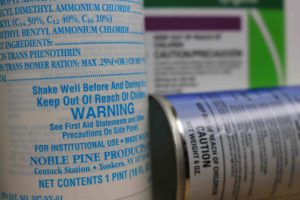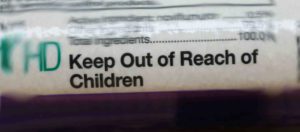WHAT IS A PESTICIDE SIGNAL WORD?
By Chris Williams on May 24, 2019.
I recently attended a gardening workshop where the speaker said we should choose garden pesticides that have a caution signal word on the label. Do you know what he meant by that?
L. A., Exeter, NH
I do know what he meant. Signal words are an important part of a pesticide’s label. They give you information about the toxicity of the particular product and EPA requires that a signal word appear on every pesticide product label. There are only three signal word options and one of them will appear in capital letters in a prominent location on the front of the label: CAUTION, WARNING, or DANGER.
You should always choose the least toxic pesticide that will get the job done – as your workshop speaker suggested. In some situations, you may discover that you don’t need pesticides at all, that weeding, or encouragement of beneficial insects, or nontoxic soaps or sprays may work just as well.
WHO DECIDES WHICH SIGNAL WORD ON WHICH PESTICIDE?
The Environmental Protection Agency requires that pesticide manufacturers submit research studies that show how poisonous their product would be to people in 3 categories: if it was eaten (oral exposure), or breathed in (inhalation exposure), or came in contact with skin (dermal exposure). They also must demonstrate whether or not use of the product could cause skin or eye irritation. The highest reaction level in any of the categories is the one that determines the product’s signal word. So, if the toxicity tests showed low toxicity when it was eaten, and low toxicity when applied to the skin, but high toxicity when inhaled, the product would be give a DANGER signal word because of the inhalation test results.

Warning and Caution Signal Words on pesticides. Z. Ciras
CAUTION –This product is low in toxicity, being only slightly toxic or relatively nontoxic with only a slight potential to cause illness or skin irritation.
WARNING –This product is moderately toxic if eaten, absorbed through the skin, or inhaled, or it causes moderate eye or skin irritation.
DANGER –This product is highly toxic by at least one of the routes of exposure. If the product may be highly toxic when eaten, absorbed through the skin, or inhaled, the label must also show the word POISON in red letters on the front panel.
THINGS TO KNOW ABOUT SIGNAL WORDS
- Signal words give information about the toxicity of the product as it is packaged for use in that particular container. You cannot extrapolate that information for other formulations of the pesticide and especially not for the concentrated form of the pesticide. Pesticides that are packaged for sale are usually diluted for use and may have a CAUTION signal word on the label while the full-strength concentrated form of the same pesticide may have a DANGER signal word.
- A signal word describes the acute, short-term toxicity of the packaged product at the time of its use and does not necessarily address possible effects from long-term or continuous exposure to the pesticide product.
- EPA requires signal words on the labels of all registered pesticides except those that fall into the very lowest toxicity category in all routes of exposure (oral, dermal, inhalation, and eye and skin irritation).
- Keep in mind that no matter what the signal word, there is no pesticide that is considered safe at high enough doses. All pose some risk. This is why EPA also requires that the statement, “KEEP OUT OF THE REACH OF CHILDREN” appear with the signal word on all pesticide labels.

Even “safer” pesticides with no Signal Word on the label will read “Keep Out of Reach of Children.” Z. Ciras
For more on choosing pesticides and understanding the label: